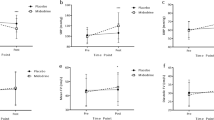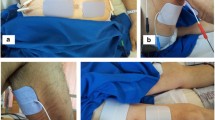Abstract
Introduction
Acetylcholine (Ach) is the pre-synaptic neurotransmitter of the sympathetic nervous system. Increased pre-synaptic Ach may augment post-synaptic release of norepinephrine, thereby increasing systemic blood pressure (BP).
Objectives
The primary objective of this investigation was to determine the hemodynamic effect of pyridostigmine bromide (PYRIDO: 60 mg), an Ach inhibitor (AchI), compared to no-drug (NO-D) during head-up tilt (HUT) in individuals with spinal cord injury (SCI). Secondarily, we aimed to determine the effects of PYRIDO compared to NO-D on symptoms of orthostatic intolerance (OI) and adverse event reporting (AE).
Methods
Ten individuals with SCI (C4-C7) were studied on two occasions: visit (1) NO-D and visit (2) PYRIDO. On each visit subjects underwent a progressive HUT maneuver to 15°, 25°, 35° for 5 min at each angle and 45 min at 45°. Supine and orthostatic heart rate (HR), systolic and diastolic BP (SBP and DBP), as well as monitored and symptoms of OI and AE were monitored and recorded.
Results
Supine hemodynamics did not differ between the trials. The significant fall in SBP during the NO-D trial was diminished with PYRIDO, and five subjects had an increased DBP during HUT with PYRIDO compared to the NO-D trial. Individuals that responded to PYRIDO with an increase in orthostatic BP had significantly lower resting HR than non-responders (p < 0.01), which suggests increased levels of pre-synaptic Ach. Subjective symptoms of OI and AE reporting did not differ between the two trials.
Conclusions
These preliminary data suggest that PYRIDO is safe and may be effective at ameliorating the orthostatic fall in BP in select individuals with SCI.





Similar content being viewed by others
References
Blackmer J (1997) Orthostatic hypotension in spinal cord injured patients. J Spinal Cord Med 20(2):212–217
Claydon VE, Krassioukov AV (2006) Orthostatic hypotension and autonomic pathways after spinal cord injury. J Neurotr 23(12):1713–1725
Claydon VE, Steeves JD, Krassioukov A (2006) Orthostatic hypotension following spinal cord injury: understanding clinical pathophysiology. Spinal Cord 44(6):341–351
Illman A, Stiller K, Williams M (2000) The prevalence of orthostatic hypotension during physiotherapy treatment in patients with an acute spinal cord injury. Spinal Cord 38(12):741–747
Duschek S, Matthias E, Schandry R (2005) Essential hypotension is accompanied by deficits in attention and working memory. Behav Med Winter 30(4):149–158
Duschek S, Weisz N, Schandry R (2003) Reduced cognitive performance and prolonged reaction time accompany moderate hypotension. Clin Auton Res 13(6):427–432
Gottesman RF, Grega MA, Bailey MM, Zeger SL, Baumgartner WA, McKhann GM et al (2010) Association between hypotension, low ejection fraction and cognitive performance in cardiac patients. Behav Neurol 22(1–2):63–71
Barrett-Connor E, Palinkas LA (1994) Low blood pressure and depression in older men: a population based study. BMJ 308(6926):446–449
Pilgrim JA, Stansfeld S, Marmot M (1992) Low blood pressure, low mood? BMJ 304(6819):75–78
Jegede AB, Rosado-Rivera D, Bauman WA, Cardozo CP, Sano M, Moyer JM et al (2010) Cognitive performance in hypotensive persons with spinal cord injury. Clin Auton Res 20(1):3–9
Wecht JM, Radulovic M, Rosado-Rivera D, Zhang RL, LaFountaine MF, Bauman WA (2011) Orthostatic effects of midodrine versus L-NAME on cerebral blood flow and the renin-angiotensin-aldosterone system in tetraplegia. Arch Phys Med Rehabil 92(11):1789–1795
Wecht JM, Rosado-Rivera D, Weir JP, Ivan A, Yen C, Bauman WA (2013) Hemodynamic effects of l-Threo-3,4-dihydroxyphenylserine (droxidopa) in hypotensive individuals with spinal cord injury. Arch Phys Med Rehabil
Vernino S, Sandroni P, Singer W, Low PA (2008) Invited article: autonomic ganglia: target and novel therapeutic tool. Neurology 70(20):1926–1932
Monge Argiles JA, Leiva SC (2007) Pyridostigmine in the treatment of primary orthostatic hypotension. Neurologia 22(4):260–262
Singer W, Opfer-Gehrking TL, Nickander KK, Hines SM, Low PA (2006) Acetylcholinesterase inhibition in patients with orthostatic intolerance. J Clinical Neurophysiol Off Publ Am Electroencephalogr Soc 23(5):476–481
Yamamoto T, Sakakibara R, Yamanaka Y, Uchiyama T, Asahina M, Liu Z et al (2006) Pyridostigmine in autonomic failure: can we treat postural hypotension and bladder dysfunction with one drug? Clin Auton Res 16(4):296–298
Provitera V, Nolano M, Pagano A (2006) Acetylcholinesterase inhibition and orthostatic hypotension. Clin Auton Res 16(2):136
Singer W, Opfer-Gehrking TL, McPhee BR, Hilz MJ, Bharucha AE, Low PA (2003) Acetylcholinesterase inhibition: a novel approach in the treatment of neurogenic orthostatic hypotension. J Neurol Neurosurg Psychiatr 74(9):1294–1298
Schondorf R (2003) Acetylcholinesterase inhibition in the treatment of hypotension. J Neurol Neurosurg Psychiatr 74(9):1187
Arterial hypertension. Report of a WHO expert committee (1978). World Health Organ Tech Rep Ser (628):pp 7–56
Zhu C, Galea M, Livote E, Signor D, Wecht JM (2013) A retrospective chart review of heart rate and blood pressure abnormalities in veterans with spinal cord injury. J Spinal Cord Med 36(5):463–475
Rosado-Rivera D, Radulovic M, Handrakis JP, Cirnigliaro CM, Jensen AM, Kirshblum S et al (2011) Comparison of 24-hour cardiovascular and autonomic function in paraplegia, tetraplegia, and control groups: implications for cardiovascular risk. J Spinal Cord Med 34(4):395–403
Norris G, Bazett HC, McMillian TM (1927) Blood Pressure and its clinical applocations, 4th edn. Lea and Febiger, Philedelphia
Shapiro MF, Korda H, Robbins J (1982) Diagnosis and treatment of low blood pressure in a Canadian community. Can Med Assoc J 126(8):918–920
Rosengren A, Tibblin G, Wilhelmsen L (1993) Low systolic blood pressure and self perceived wellbeing in middle aged men. BMJ 306(6872):243–246
Wessely S, Nickson J, Cox B (1990) Symptoms of low blood pressure: a population study. BMJ 301(6748):362–365
Niu K, Hozawa A, Awata S, Guo H, Kuriyama S, Seki T et al (2008) Home blood pressure is associated with depressive symptoms in an elderly population aged 70 years and over: a population-based, cross-sectional analysis. Hypertens Res 31(3):409–416
Hildrum B, Mykletun A, Holmen J, Dahl AA (2008) Effect of anxiety and depression on blood pressure: 11-year longitudinal population study. Br J Psychiatry 193(2):108–113
Hildrum B, Mykletun A, Stordal E, Bjelland I, Dahl AA, Holmen J (2007) Association of low blood pressure with anxiety and depression: the Nord-Trondelag Health Study. J Epidemiol Community Health 61(1):53–58
Jorm AF (2001) Association of hypotension with positive and negative affect and depressive symptoms in the elderly. Br J Psychiatry 178:553–555
Kim BS, Bae JN, Cho MJ (2010) Depressive symptoms in elderly adults with hypotension: different associations with positive and negative affect. J Affect Disord 127(1–3):359–364
Paterniti S, Verdier-Taillefer MH, Geneste C, Bisserbe JC, Alperovitch A (2000) Low blood pressure and risk of depression in the elderly. A prospective community-based study. Br J Psychiatry 176:464–467
Stroup-Benham CA, Markides KS, Black SA, Goodwin JS (2000) Relationship between low blood pressure and depressive symptomatology in older people. J Am Geriatr Soc 48(3):250–255
Carlozzi NE, Fyffe D, Morin KG, Byrne R, Tulsky DS, Victorson D et al (2013) Impact of blood pressure dysregulation on health-related quality of life in persons with spinal cord injury: development of a conceptual model. Arch Phys Med Rehabil 94(9):1721–1730
Weisz N, Schandry R, Jacobs AM, Mialet JP, Duschek S (2002) Early contingent negative variation of the EEG and attentional flexibility are reduced in hypotension. Int J Psychophysiol Off J Int Org Psychophysiol 45(3):253–260
Costa M, Stegagno L, Schandry R, Bitti PE (1998) Contingent negative variation and cognitive performance in hypotension. Psychophysiology 35(6):737–744
Wecht JM, Bauman WA (2013) Decentralized cardiovascular autonomic control and cognitive deficits in persons with spinal cord injury. J Spinal Cord Med 36(2):74–81
Wecht JM, Rosado-Rivera D, Jegede A, Cirnigliaro CM, Jensen MA, Kirshblum S et al (2012) Systemic and cerebral hemodynamics during cognitive testing. Clin Auton Res 22(1):25–33
Krassioukov A, Warburton DE, Teasell R, Eng JJ (2009) A systematic review of the management of autonomic dysreflexia after spinal cord injury. Arch Phys Med Rehabil 90(4):682–695
Acknowledgments
This research was supported by the Veterans Affairs Rehabilitation Research and Development Service (Grant # B9212C).
Conflict of interest
We certify that no party having a direct interest in the results of the research supporting this article has conferred or will confer a benefit on us or on any organization with which we are associated and, if applicable, we certify that all financial and material support for this research (e.g., NIH or NHS Grants) and work is clearly identified in the title page of the manuscript.
Author information
Authors and Affiliations
Corresponding author
Rights and permissions
About this article
Cite this article
Wecht, J.M., Cirnigliaro, C.M., Azarelo, F. et al. Orthostatic responses to anticholinesterase inhibition in spinal cord injury. Clin Auton Res 25, 179–187 (2015). https://doi.org/10.1007/s10286-015-0272-3
Received:
Accepted:
Published:
Issue Date:
DOI: https://doi.org/10.1007/s10286-015-0272-3




